…[1]
The 19th century in Wales was characterised by outbreaks of religious revival and references to local movements frequently appear in the Denbigh Asylum records. Even when an attack of insanity was not directly assigned to a revival meeting, delusions and hallucinations of a religious nature are commonly described in the reception orders.
Charismatic travelling preachers encouraged intense and sometimes uninhibited worship and by the latter half of the century the non-conformist chapel had become the centre of spiritual, educational and social life in the towns and villages of North West Wales. There were evening prayer meetings and ‘experience meetings’ where spiritual problems could be discussed with fellow believers. Sermons were analysed and discussed and missionary stories told. At Sunday School children were encouraged to learn passages from the Bible by heart.
Religious mania typified by visions of the devil and the belief that ‘the Devil personally appears to him’[2] or melancholia with ‘a determined opinion of the hopeless state of his soul’[3] might have been an outcome of this heightened spiritual experience. Other asylum admissions hint at the social force of the chapel. Owen Jones’s mental distress was ascribed to accusations that he was not fit to hold the position of deacon at his chapel because his wife had given birth to a child ‘shortly after wedlock’[4] and when Hugh Roberts, a labourer from Llanfaelog, was certified in 1889 one of the indications of his insanity was thought to be that ‘although in a strange Chapel, he took the lead in the singing’.[5] No cause for David Williams’s insanity could be assigned beyond the fact that he had quarrelled in his chapel at Blaenau Ffestiniog about the minister.[6] Ellen Williams’s attack of mania was linked to a disagreement with a neighbour although it ‘began in the form of a condition of Religious Excitement called by the Calvinists ‘Gorfoleddu’ or ‘Rejoicing’….she went about singing and speaking in a sing-song style very common at Revivals among the Welsh Calvinists’.[7]
However, as the 19th century drew to a close it seemed that the radical evangelical message of Welsh nonconformity was becoming the new conformity. Attendances at sermons, prayer meetings and Sunday school were falling and young women – and some young men – preferred reading novels to their Bibles. At the same time intemperance was on the rise with ‘the curse of drink rearing its head in town and countryside’[8]. Many people began to hope for another spiritual awakening.
During October 1904 Evan Roberts, an apprentice blacksmith who had moved from his home in Loughor in South Wales to Newcastle Emlyn to prepare for full time training as a minister, became convinced that it was his personal duty to evangelise Wales and the visions he experienced at this time confirmed to him that a great revival was imminent.
And so it was. After the first meeting in Loughor, news of revival spread across Wales with newspapers publishing eye witness accounts of revival meetings and sometimes issuing special ‘revival editions’ like the one below published in January 1905 at Dolgellau.
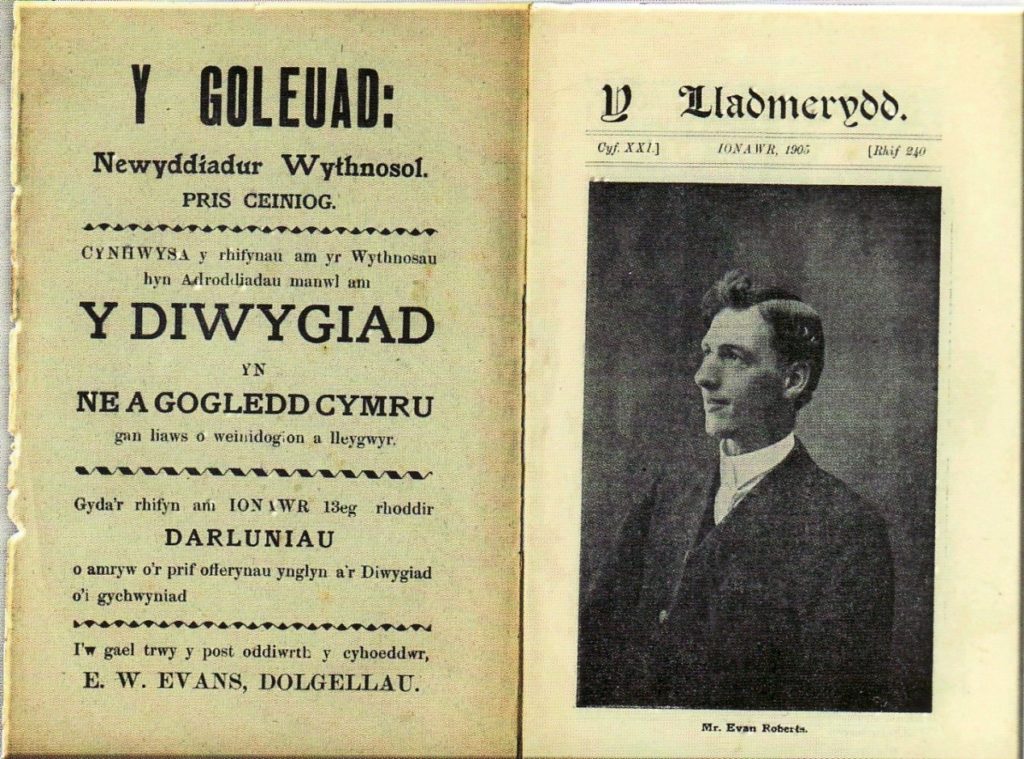
The date of the leaflet suggests that religious fervour was sweeping across North Wales months before Evan Roberts brought his mission here for the first time in April 1905. The strength of the revival, which is evidenced in asylum admissions from late 1904, suggests that other charismatic preachers like the Revd. J.T. Job, pastor in Carneddi, Bethesda, had done much of the groundwork for him.
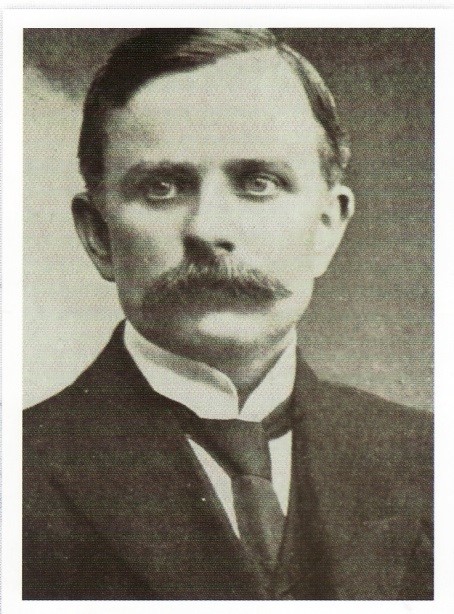
The Revd. Job described a meeting at Jerusalem Chapel in Bethesda held on 22nd December 1904 ‘as a hurricane’.
John Thomas Job (1867-1938) moved to Carneddi from Aberdare in South Wales in 1898. He wrote several hymns for the Welsh Calvinist Methodist hymn book and won the chair for his poetry at the national Eisteddfod in 1897, 1903, 1918 and the crown in 1900. He also won the chair at the San Francisco Eisteddfod of 1915.[9]
By the time Evan Roberts arrived on Anglesey in June revival meetings were held wherever the crowds they attracted could be accommodated. A line drawing recalls Evan Roberts preaching to 3,000 people gathered in what appears to be a collection of farm buildings at Llanfachreth in June ‘from the pulpit of the great John Elias’[10] … (see ‘Y Pab Methodistaidd’).
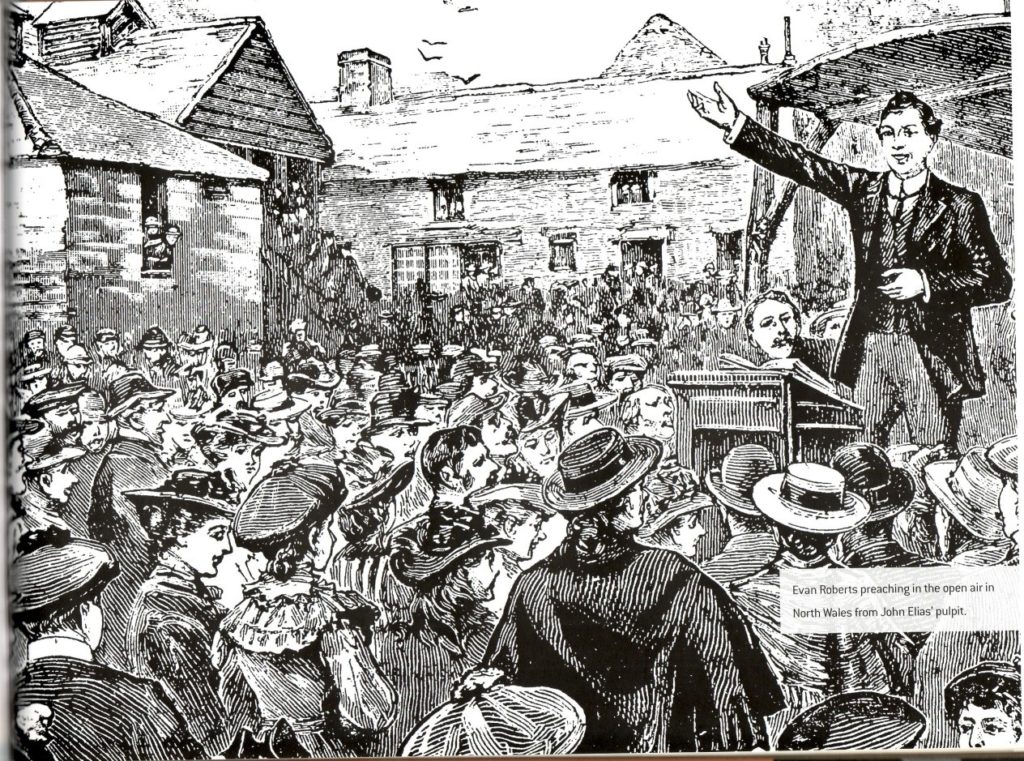
….while a Western Mail postcard has him taking the revival message to crowds congregated in a field at Llanfairpwll on the final day of his Anglesey journey before moving on to Caernarfon and Bala.
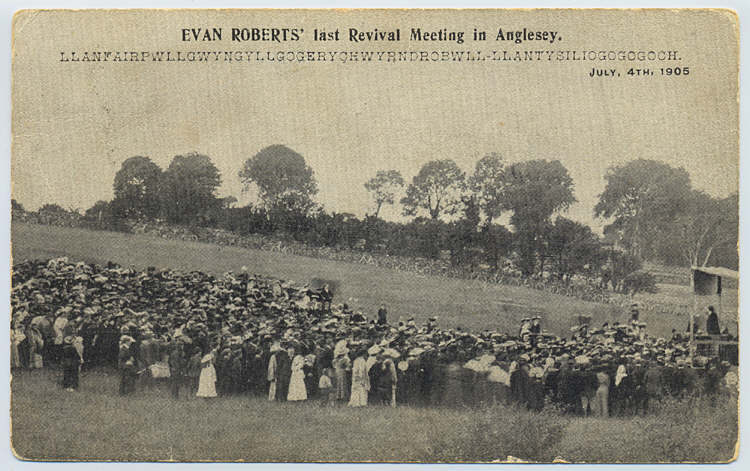
It is difficult to look at the case notes of the people admitted to Denbigh Asylum in 1905 with a diagnosis of religious mania or melancholia without questioning how their visions and behaviour differed from the visions and behaviour of Evan Roberts; how one person’s experience could be considered evidence of their insanity and another person’s experience accepted as testimony to the work of God.
In 1902 the American philosopher William James published The Varieties of Religious Experience in which he examined how mystical experiences could be identified as either psychotic or spiritual while sharing much common ground and recent studies have supported his view of a close relationship between madness and inspiration.[11]
How is it possible draw a distinction between Evan Roberts’ vision of ‘a diabolic face that had mocked him in the garden at the back of his lodgings’ – a vision he insisted was not subjective[12] – and the devil seen by William Jones, a 19 year old grocer’s assistant, after he had attended a revival meeting in Portmadoc?[13] And how significantly did quarryman Robert Evans’ visions and conviction that he had been ‘especially ordained by the spirit to preach’[14] differ from Evan Roberts’ visions and voices:
‘You must go, you must go (to preach)…and I asked whether it was the devil or the spirit’?[15]
Amongst the revivalist’s recorded visions were ‘visions of Hell’s doors being closed for a year, pictures of Satan’s defeat at the hand of Christ, a cheque with the number 100,000 written on it, the light of a candle being overtaken by the light of the sun’[16] and these he was happy to share at his meetings. It is hard to find visions in the Denbigh case notes more elaborate than these.
In fact, anxieties about Evan Roberts’ mental state were being expressed from the beginning of his mission. He lodged with Evan Phillips, the 1859 revival leader, and his family in Newcastle Emlyn during the autumn of 1904. Ann Phillips had been told ‘to keep an eye on him’ and her sister Rachel records that ‘…what burdened us was care for his mental condition’. A reporter from the Llanelli Mercury reported in November 1904 that the revivalist was showing signs of severe mental strain:
The long vigils of the week had evidently told on him and the more so as he had been able to sleep but little. However there were no signs of fatigue in his conversation. He walked up and down the little room with a restlessness that told of a brain ever at work. At times he would break out into singing snatches of hymns.
The case notes for Rowland Griffith Davies, committed to Denbigh in January 1905 (6493) make for very similar reading. They describe the 16 year old butcher’s errand boy as suffering from ‘great mental unrest’ and ‘singing hymns and praying continually’.[17]
Professor John Young Evans, who met Evan Roberts in March 1905, describes his apparent need to consult with the Spirit before making every day to day decision such as when he was asked whether he would see someone who had come to speak to him or where he would next preach.
He hesitated before replying, while his lips were slightly but perceptibly convulsed…The increase of emphasis he now lays on the Spirit’s guidance even in temporal affairs easily lent itself to satire and caricature.[18]
In the case of others, perhaps to an asylum admission!
A Llanberis minister also expressed his concerns about the revivalist’s state of mind in the Western Mail:
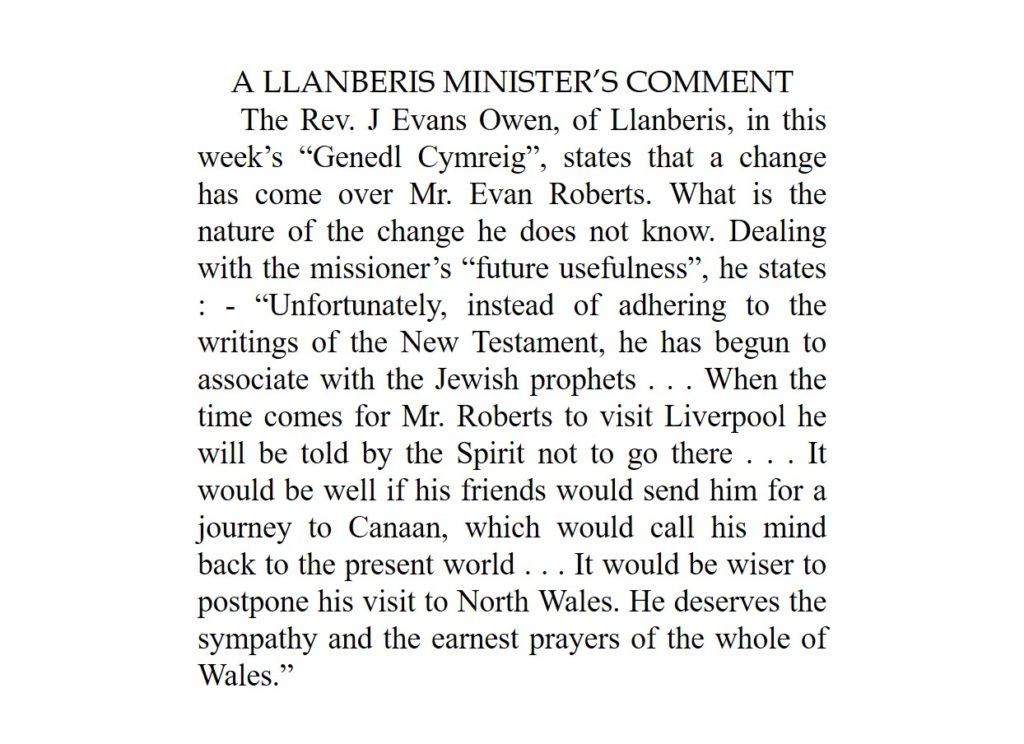
In Liverpool Evan Roberts abruptly dismissed the members and congregation of one church, giving rise to more calls for him to take a rest, and the services he conducted in Newcastle Emlyn after his return were described as ‘very strange to say the least’.[19]
It was said that by the autumn of 1906 revival meetings had left Evan Roberts ‘unable to stand or walk for almost a twelvemonth’[20] and, although he eventually regained enough strength to publish a new magazine and attend the occasional conference, the great wave of religious fervour he had overseen in Wales did not last. The extraordinary revivalist lived out his life in Cardiff and died there in 1951 at the age of 72.
Footnotes
[1] Cormac McCarthy, Cities of the Plain (1998).
[2] DRO/HD/1/361/Case no. 2964
[3] DRO/HD/1/362/Case no. 3247
[4] DRO/HD/1/367/Case no. 4529
[5] DRO/HD/1/365/Case no. 4039
[6] DRO/HD/1/364/Case no. 3916
[7] DRO/HD/1/333/Case no. 3326
[8] A Diary of Revival: The outbreak of the 1904 Welsh Awakening, Kevin Adams (2004), p 20
[9] National Library of Wales, Dictionary of Welsh Biography.
[10] Kevin Adams and Emyr Jones, A Pictorial History of Revival: The Outbreak of the 1904 Welsh Awakening CWR (2004).
[11] Jackson, M, The Paradigm-Shifting Hypothesis: A common process in benign psychosis and psychotic disorder. In Isabel Clarke (ed.) Psychosis and Spirituality: Consolidating the new paradigm, John Wiley & Sons (2010).
[12] Kevin Adams, Diary of Revival: The Outbreak of the 1904 Welsh Awakening CWR (2004).
[13] DRO/HD/1/374/Case no. 6591
[14] DRO/HD/1/374/Case no. 6509
[15] Kevin Adams, Diary of Revival: The Outbreak of the 1904 Welsh Awakening CWR (2004) p.86
[16] Kevin Adams, Diary of Revival: The Outbreak of the 1904 Welsh Awakening CWR (2004) p.140
[17] DRO/HD/1/374/Case no. 6493
[18] Kevin Adams, Diary of Revival: The Outbreak of the 1904 Welsh Awakening CWR (2004) p.131. When he met Evan Roberts in 1905, John Young Evans was professor at Trefeca College, Brecon, a post he had been offered while still studying classics at Oxford in 1891. The following year he moved to the new United Theological College at Aberystwyth and was appointed Dean of the University of Wales faculty of theology in 1922.
[19] Kevin Adams, Diary of Revival: The Outbreak of the 1904 Welsh Awakening CWR (2004) p. 134
[20] Kevin Adams, Diary of Revival: The Outbreak of the 1904 Welsh Awakening CWR (2004) p.145
